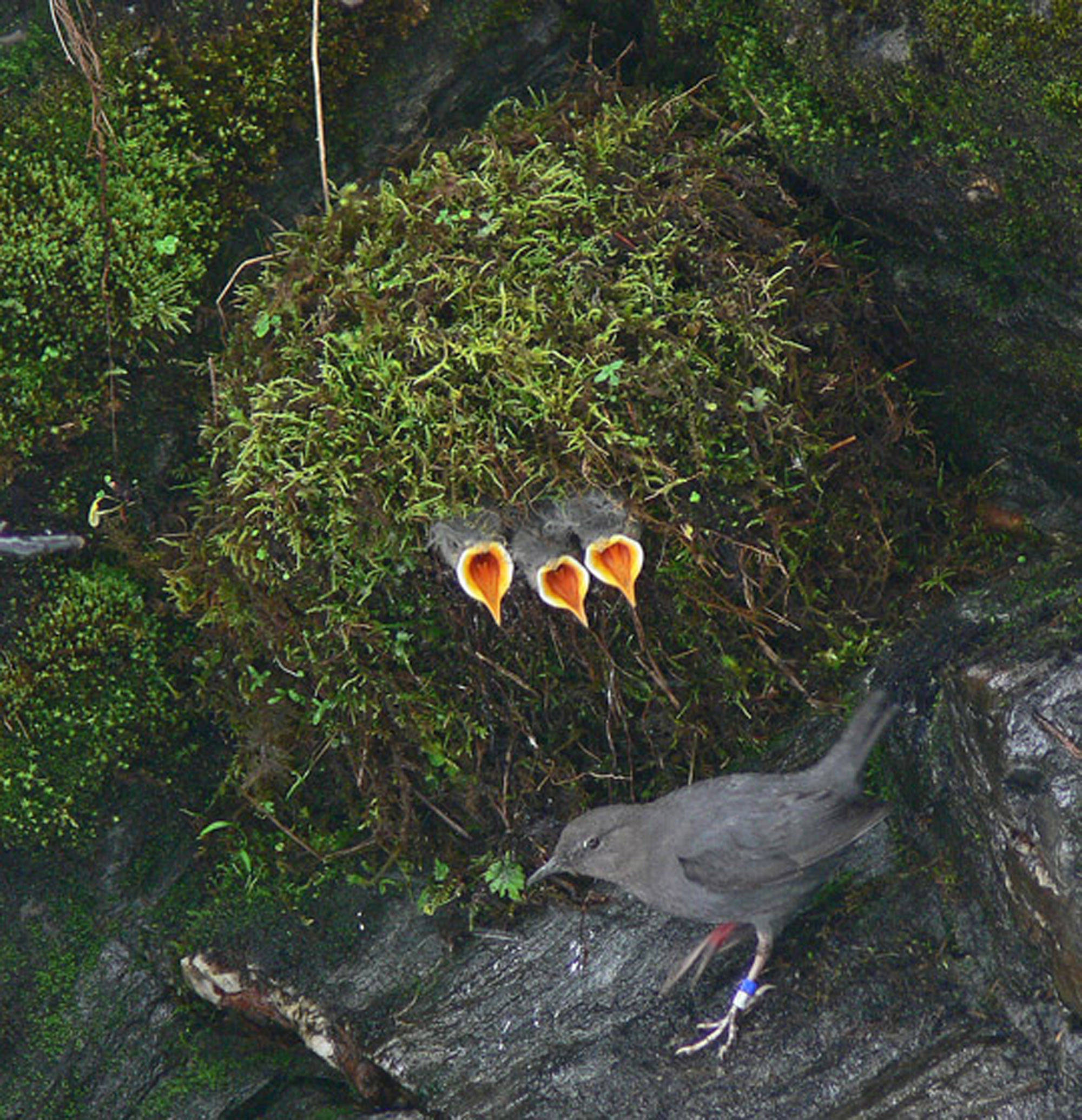Four baby juncos, in a nest tucked under a drooping clump of grass, lie low and are very quiet. Only when their parents come with food do they raise their heads and beg. When the parents leave, the chicks again are still. There’s a good reason for this: a nestful of lively, loud chicks would probably attract predators, which are always on the watch for succulent little morsels. Even the repeated back-and-forth trips of attentive parents are often enough to alert watchful predators to the location of a nest.
The nestlings of many other songbirds (robins, sparrows, warblers, etc.) behave in the same way, for the same reasons. They nest in open-cup nests, which are vulnerable to all comers. Cavity-nesters, such as woodpeckers, can be a little more brash, in their protective holes. Predators may come, but only some of them can enter or reach into a deep cavity, and if they do, they may face a barrage of sharp beaks. Predation rates on cavity-nesters are much lower than on open-cup nesters. As the chicks get bigger, they sometimes perch right next to their front door, poking their heads out and yelling for food (that’s how I easily found the nest of a black-backed woodpecker, some years ago).
Ducks and shorebirds do it differently. Wherever they nest, the chicks leave the nest soon after hatching, typically following a parent around but feeding themselves. When incubation is done, there are no back-and-forth parental feeding trips to lure a predator to a particular place. The family is now a moving target, not a stationary one.
Among mammals that are subject to predation, we find a similar dichotomy. The young of some species follow their mothers, but in other species, the babies cuddle in a nest. Humpback whale calves stay close to their mothers, and recent research shows that they talk to them in “whispers” — soft vocalizations that cannot be heard at any distance. This may reduce the risk of killer whale attacks. The young of deer, moose, zebras, elephants and other large herbivores are also able to accompany their mothers soon after birth; I wonder if they whisper, too!
Young marmots stay near the den, which offers a quick retreat when danger threatens, and young beavers gain some protection from the pond outside the lodge, a haven when the alarm sounds. Smaller mammals have a variety of arrangements, mostly depending on being cryptic and hard to find.
But some small rodents add another feature that improves safety: they can produce ultrasound. Too high-pitched for human ears (hence, “ultra”), these sounds have a very short wavelength along with the very high frequency. Such sounds attenuate rapidly with distance, so they do not carry very far; they are more directional than low-frequency sounds, but they get scattered by reflecting off twigs and leaves. Young lemmings, mice and rats emit ultrasounds to call their mothers if they have become separated too long. The calls prompt the mother to retrieve the wandering pups. Although many predators of small rodents cannot hear ultrasound, some can (e.g., dogs and cats and their relatives), and a short-range call of distress might reduce the risk of predation from such carnivores.
Adult small rodents also use ultrasound as a form of social communication within a group, quiet talk among companions. Certain ground squirrels emit ultrasounds that alert others to the presence of a distant threat, the rapid attenuation ensuring that the sound does not carry as far as the potential threat and thus telling it that the squirrels are aware of its presence.
On the other hand, some predators have evolved the ability to use ultrasound in hunting — as an aid to predation (rather than a way to avoid it). The toothed whales use echolocation (sonar), much of it in the ultrasonic range, to navigate in turbid waters and to detect their prey. Our resident killer whales, for instance, use ultrasound to locate and capture their fish; the transient killer whales, however, seldom use it while hunting their prey of marine mammals. Not only are the prey mammals much larger and easier to see than the prey fish, typically, they are also more likely to be able to hear the sonar calls of the hunting killer whales. So the transients usually hunt silently.
Bats are perhaps the best-studied predators that hunt using ultrasound. The short wavelengths permit the sounds to bounce off small prey, such as insects, and bats emit very high intensity (“loud”) ultrasounds as they close in on a hapless bug. Not all insects are hapless, however! Some toxic tiger moths make ultrasonic clicks to warn off approaching bats, which then often abort their attack. Other, nontoxic, tiger moths use their ultrasound to jam the sonar of an attacking bat, making the attack less likely to be successful.
Echolocating calls sometimes also allow the bats to communicate with one another, as they are looking for roosts or food. Because the calls can be individually recognizable, young bats can communicate with their mothers, and friends can talk to each other (although others may eavesdrop). There remains much to be learned about the social uses of sound in bats.
• Mary F. Willson is a retired professor of ecology.

